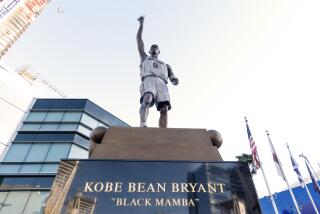Anti-doping authorities don’t play fair against athletes
- Share via
With the whole world atwitter over Tour de France champ Lance Armstrong’s decision to drop his legal fight against anti-doping allegations, it’s the right moment to be appalled at the travesty in sports this case represents.
It’s not that the case will be seen as a major victory for sports anti-doping authorities. It’s that the anti-doping system claiming its highest-profile quarry ever is the most thoroughly one-sided and dishonest legal regime anywhere in the world this side of Beijing.
It’s a system deliberately designed to place almost insurmountable hurdles in the way of athletes defending themselves or appealing adverse findings. Evidence has emerged over the years that laboratories certified by the World Anti-Doping Agency, or WADA, have been incompetent at analyzing athletes’ samples or fabricated results when they didn’t get the numbers they were hoping to see.
Athletes’ defense attorneys harbored some hope that by picking a fight with Lance Armstrong, the anti-doping system might have sowed the seeds for its own reform. Finally, it was thought, here was an athlete with the money and motivation to expose the legal sophistry, the pseudoscience, the sheer sloppiness that underlies sports anti-doping prosecutions all over the world.
Instead, the outcome shows that the system is so relentlessly rigged that even Lance Armstrong doesn’t see a point in fighting it.
“We’re talking about three, four, five years of litigation,” says Mark Levinstein, a veteran sports lawyer and a member of Armstrong’s legal team. “Who in his right mind would or could go through that?”
Before we go further, let’s address the question most people think is the nub of the matter. Is Lance Armstrong a doper?
Here’s the answer: I don’t know. You don’t know either. More to the point, Travis Tygart, head of the U.S. Anti-Doping Agency, doesn’t know. That hasn’t kept USADA from declaring Armstrong to be guilty of charges it has not proved in public, or to attempt to strip him of his seven Tour de France titles. (It’s not yet clear that USADA has the latter authority.)
And there lies what is, in fact, the nub of the matter. It shouldn’t matter if you believe Armstrong doped in winning his titles. You should still be appalled, even frightened, by the character of the prosecution.
In part that’s because under the rules written by the anti-doping system, athletes’ cases are heard not in a court of law but in arbitration.
Arbitration is a system that more Americans are becoming familiar with, to their misfortune and distaste. It’s where banks, brokerages, cellphone companies and other powerful business institutions force their customers to litigate grievances, for the simple reason that arbitration systems favor those who use them the most — banks, brokerages, cellphone companies, etc.
The real secret of why anti-doping agencies have been able to hound athletes out of their sports with impunity is that in this system they’re not only the prosecutors but also the judges and juries. They write the arbitration rules, including those governing what evidence is relevant and under what circumstances it can be questioned.
Defending oneself in this system is horrifically expensive. The hiring of lawyers and scientific experts, the cost of visiting labs in foreign lands and attending hearings all over the country can drive a routine defense to six figures.
How many amateur athletes have the resources to do that? So most defendants give in and accept a suspension for a year or more. But countless innocent athletes, or competitors whose violations are clearly the result of an accident or blameless error, carry the stigma of cheater because they couldn’t afford a defense.
“You’re up against a prosecutor who drafts the rules, and goes back and changes the rules when they go against him,” says Michael Straubel, director of the sports law clinic at Valparaiso University Law School and a defense attorney who handed USADA one of its rare defeats in an arbitration case.
The Lance Armstrong case has inspired several such stealth rule changes.
For example, World Anti-Doping Agency rules provide for an eight-year statute of limitations, meaning that anti-doping agencies aren’t supposed to use test results older than that to bring charges against an athlete. But Armstrong has pointed out that USADA was basing its case against him on test results as much as 14 years old. Presto: WADA is proposing to update its statute of limitations to 14 years — and it’s proposing that the update be retroactive.
Federal Judge Sam Sparks of Austin, Texas, who was asked by Armstrong to block USADA’s case against him, found lots not to like about the agency’s pursuit of the cyclist. He called USADA’s charging document, a letter that listed Armstrong’s purported doping violations, “so vague and unhelpful it would not pass muster in any court in the United States.” The deficiency, he said, “is of serious constitutional concern.”
He questioned whether USADA’s real goal in bringing the charges was to combat doping in sports as it claimed, or whether its motivation was “less noble.” Armstrong had argued that the case reflected a vendetta against him by anti-doping authorities, possibly conceived after he blew to smithereens leaked accusations against him in 2005, embarrassing a major WADA lab in the process.
Yet despite his concerns, Sparks last week dashed Armstrong’s hopes on the same shoal that has wrecked the defenses of other athletes. He ruled that by competing in sports events, Armstrong implicitly agreed to arbitrate any doping charges against him. In other words, the matter was out of the court’s hands.
And sure enough, anti-doping prosecutors almost never lose an arbitration. USADA has won all but three cases it has brought to arbitration since 2000. That’s a record, it likes to suggest, that points to its unrivaled skill and integrity.
It should be obvious that if USADA’s lawyers were that good they wouldn’t be wasting their time badgering athletes for taking a Sudafed before competing or not being at home when drug testers arrive to take a random urine sample; they’d be making national news prosecuting Mafia killers or Wall Street bankers. (Test scheduling issues have constituted nearly 95% of USADA’s caseload, according to its own figures.)
On the rare occasions when anti-doping prosecutors have to bring their cases before a legitimate court, they almost never win. Roger Clemens: two trials, zero convictions. Barry Bonds: four charges, one conviction (for obstruction of justice). After spending months pondering whether to bring Armstrong to trial for doping misdeeds, federal prosecutors abandoned the case in February.
You may choose to believe that Clemens, Bonds and Armstrong are guilty based on the size of their craniums or their superhuman physical achievements. But on the rare occasions when the facts have been tested in a courtroom subject to the rules of due process and evidentiary standards afforded ordinary Americans, they haven’t measured up.
The biggest problem with the sports anti-doping system is that it’s driven by anti-drug hysteria, not by reasoned judgments about what we expect from our athletes and what technological assistance should be permitted.
The same people lining up to brand Lance Armstrong a cheater will worship a pitcher who undergoes Tommy John transplant surgery to save his career. The Oakland A’s Bartolo Colon will be missing 50 games for taking testosterone, but what about the batters he’s faced who have had their eyeballs surgically refabricated with Lasik so they can read his pitches better?
Is the rule that it’s OK to enhance your performance by scalpel but not by hypodermic needle? Then let’s discuss that and establish exactly what the grounds are for the distinction. Until we clear that up, along with why caffeine isn’t on the banned list but marijuana is, athletes will try anything they can to beat their records, thrill the masses and make money. And why not?
It’s all well and good to say the goal of the anti-doping system is to ensure that sports stay clean, and it’s certainly true that clean athletes have every reason to resent having to compete against cheaters.
But we’ve created a strange way to uphold these principles — a system that writes its own rule book, moves the goal posts at will, lies and fabricates to get the score it wants and fiercely resists playing before an objective umpire. Whatever you choose to think of Lance Armstrong, his case is just one more indication that the supposed guardians of honesty and integrity in sports are among the filthiest players of all.
Michael Hiltzik’s column appears Sundays and Wednesdays. Reach him at [email protected], read past columns at latimes.com/hiltzik, check out facebook.com/hiltzik and follow @latimeshiltzik on Twitter.
More to Read
Inside the business of entertainment
The Wide Shot brings you news, analysis and insights on everything from streaming wars to production — and what it all means for the future.
You may occasionally receive promotional content from the Los Angeles Times.











